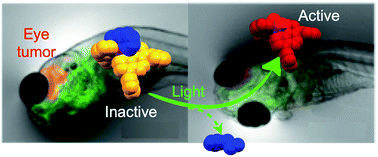Photosubstitution in a trisheteroleptic ruthenium complex inhibits conjunctival melanoma growth in a zebrafish orthotopic xenograft model†
Abstract
In vivo data are rare but essential for establishing the clinical potential of ruthenium-based photoactivated chemotherapy (PACT) compounds, a new family of phototherapeutic drugs that are activated via ligand photosubstitution. Here a novel trisheteroleptic ruthenium complex [Ru(dpp)(bpy)(mtmp)](PF6)2 ([2](PF6)2, dpp = 4,7-diphenyl-1,10-phenanthroline, bpy = 2,2′-bipyridine, mtmp = 2-methylthiomethylpyridine) was synthesized and its light-activated anticancer properties were validated in cancer cell monolayers, 3D tumor spheroids, and in embryonic zebrafish cancer models. Upon green light irradiation, the non-toxic mtmp ligand is selectively cleaved off, thereby releasing a phototoxic ruthenium-based photoproduct capable notably of binding to nuclear DNA and triggering DNA damage and apoptosis within 24–48 h. In vitro, fifteen minutes of green light irradiation (21 mW cm−2, 19 J cm−2, 520 nm) were sufficient to generate high phototherapeutic indexes (PI) for this compound in a range of cancer cell lines including lung (A549), prostate (PC3Pro4), conjunctival melanoma (CRMM1, CRMM2, CM2005.1) and uveal melanoma (OMM1, OMM2.5, Mel270) cancer cell lines. The therapeutic potential of [2](PF6)2 was further evaluated in zebrafish embryo ectopic (PC3Pro4) or orthotopic (CRMM1, CRMM2) tumour models. The ectopic model consisted of red fluorescent PC3Pro4-mCherry cells injected intravenously (IV) into zebrafish, that formed perivascular metastatic lesions at the posterior ventral end of caudal hematopoietic tissue (CHT). By contrast, in the orthotopic model, CRMM1- and CRMM2-mCherry cells were injected behind the eye where they developed primary lesions. The maximally-tolerated dose (MTD) of [2](PF6)2 was first determined for three different modes of compound administration: (i) incubating the fish in prodrug-containing water (WA); (ii) injecting the prodrug intravenously (IV) into the fish; or (iii) injecting the prodrug retro-orbitally (RO) into the fish. To test the anticancer efficiency of [2](PF6)2, the embryos were treated 24 h after engraftment at the MTD. Optimally, four consecutive PACT treatments were performed on engrafted embryos using 60 min drug-to-light intervals and 90 min green light irradiation (21 mW cm−2, 114 J cm−2, 520 nm). Most importantly, this PACT protocol was not toxic to the zebrafish. In the ectopic prostate tumour models, where [2](PF6)2 showed the highest photoindex in vitro (PI > 31), the PACT treatment did not significantly diminish the growth of primary lesions, while in both conjunctival melanoma orthotopic tumour models, where [2](PF6)2 showed more modest photoindexes (PI ∼ 9), retro-orbitally administered PACT treatment significantly inhibited growth of the engrafted tumors. Overall, this study represents the first demonstration in zebrafish cancer models of the clinical potential of ruthenium-based PACT, here against conjunctival melanoma.



 Please wait while we load your content...
Please wait while we load your content...